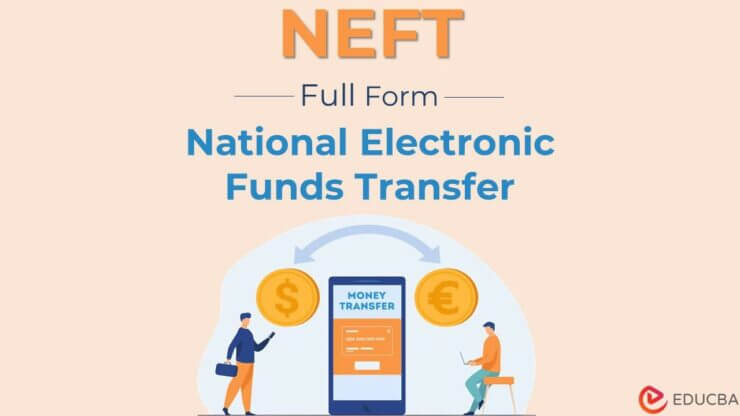Updated February 9, 2023
What is NEFT?
Transfer of funds from one account to the other has become very simple. If you wish to transfer the money, you don’t need to draw cheques, withdraw money, or issue cash order requests. You can now transfer funds according to your convenience at any time of day. Let’s understand more about full form of NEFT and how they function.
Full Form of NEFT
There are several methods, one of which is NEFT, the Full Form of NEFT is National Electronic Fund Transfer. Many banks utilize the National Electronic Fund Transfer (NEFT) system for payments across the country. It enables the transfer of funds quickly and easily across bank accounts. The idea of NEFT has gained wide acceptance in the nation as the world continuously shifts towards internet banking. It is a simple way to transfer money without visiting the bank since you can do so from home.
Features of NEFT
One of the many ways to send money online is through the National Electronic Funds Transfer system. The RBI and its functions govern it in adherence to the regulations issued by the RBI. Its features include:
- One-to-one payments are attainable using NEFT.
- Only banks that provide NEFT-enabled services can facilitate an NEFT.
- You should first enroll recipients on your required bank’s online banking portal to send money using NEFT.
- The number of NEFT transactions is unlimited.
- According to RBI norms, NEFT transactions are processed and cashed in batches every half-hour.
- All NEFT transactions are subject to a charge, which ranges from Rs. 2.5 to Rs. 25 based on the amount of funds transferred.
Advantages of using NEFT
By using the NEFT funds transfer method, you get various advantages. These include:
- Since every NEFT transaction occurs online, a third party is never involved.
- Money transfer is simple, efficient, and practical thanks to NEFT.
- Immediately after the transaction is complete, both the sender and the receiver of the funds are informed.
- Every account holder can conduct NEFT transactions, including individuals, businesses, and corporations. The only requirement is that both parties’ banks must approve NEFT.
- NEFT is cost-effective since it eliminates the need for a demand draft or cheque while transferring money.
- You can use NEFT to pay your loan payments, credit or debit card dues, EMIs, and other bills in addition to transferring money.
Timings of NEFT Transactions
Until December 2019, NEFT transfers could only be carried out on weekdays from 8:00 AM to 6:30 PM and on weekends from 8:00 AM to 12:30 PM. On Sundays, the NEFT facility was unavailable. However, NEFT transactions were made available 24/7 from any location since January 2020.
How to Make an NEFT Transfer?
To make a successful NEFT transfer, all you need to do is follow these easy steps:
Step 1: Log in to your internet banking account. Sign up for an online banking account on your bank’s webpage, if you don’t already have one.
Step 2: Set up the receiver as a payee. To accomplish this, you must fill out the beneficiary’s information in the “Add New Payee” section using a few essential details:
- Name of the recipient
- Account number
- IFSC code of the recipient’s bank
- Type of account
Step 3: Select NEFT as the mode of Money Transfer after the payee has been added.
Step 4: Choose the account you want to send funds from, select the recipient, and enter the transfer amount with a description.
Step 5: The sum will be sent from your account to the others after you click “Confirm.”
How to Track the Status of a Transaction?
After you make the payment, you get to track the status of your transaction by following these steps:
- The sender and receiver can keep track of the NEFT transfer by contacting their respective bank’s NEFT Customer Facilitation Centre.
- Customers can find information on NEFT CFCs of banks from the websites of their selected banks.
- The customer must provide the associated bank with transaction information such as the Unique Transaction References (UTR) number/reference number of transaction, date of money transfer, and so on If they wish to monitor the transaction instantly.
What is the Transfer Limit on NEFT?
NEFT fund transactions can start from Rs. 1 onwards. However, the RBI hasn’t established a limit for this, you can send up to Rs. 50,000 in cash per transaction. Additionally, there is no restriction on the total sum transferable, though few banks have established their maximum limits. For instance, Rs. 25 lakhs daily in HDFC Bank.
Conclusion
Transferring money is now a work of a few seconds. All you require is an internet connection, a device, and the receiver’s bank details. NEFT is an excellent method for transferring money, saving you a lot of time. Now, in case of an emergency or urgency, you can send money within just a few minutes! You can also keep track of your transactions and make sure that the money is transferred successfully.

